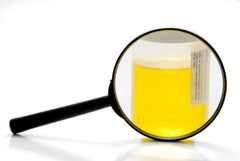
There is more than one form of estrogen. There are three primary circulatory forms and from those three, estrogen can convert into hundreds of different metabolites. Estrogen metabolites have similar effects; however, based on a variety of chemical side-groups, each metabolite can differ in estrogen potency.
The metabolism of the primary circulatory estrogens and the subsequent metabolites can impact your risk of proliferative diseases such as breast cancer and endometriosis, where cells can multiply quickly and spread. Some estrogen metabolites are less proliferative and more protective whereas others are more proliferative and less protective. Obviously, we want you to have more of the protective ones.
The 2-to-16 Estrogen Ratio
As mentioned, there are literally hundreds of estrogen metabolites. It’s impossible to measure all of them for their proliferative or protective effects. Instead, we can measure a few metabolites that then can act as representatives for the rest.
For instance, one of the less proliferative and more protective metabolites is called 2-hydroxyestrone. It’s easily measured in your urine and can act as the protective group’s representative. Conversely, 16-alpha-hydroxyestrone is a more proliferative, less protective metabolite. It also is easily measured and can act as the proliferative group’s representative.
Comparing the levels of the two representatives, we come up with the 2-to-16 ratio. Another way of saying this is the Protective-to-Proliferative ratio. Now, is this a complete picture of your estrogen profile? Of course not!
But it gives us a window into your body’s inventory of estrogen metabolites and whether it’s balanced towards protective or proliferative ones. And this can impact your health.
A Higher Ratio is Optimal
A 2-to-16 estrogen ratio greater than 1 should be protective against proliferative diseases. From a study published in the Journal of Women’s Health, the authors stated, “Among post-menopausal women, breast cancer risk is inversely associated with circulating levels of 2-hydroxyestrone but directly associated with levels of 16-alpha-hydroxyestrone, according to most studies.”1
Using this statement as our premise, we can conclude that a higher 2-to-16 ratio is inversely associated with breast cancer risk.
However, if your ratio is greater than 1, does it absolutely mean your risk for breast cancer and other proliferative diseases is lower? No, because very few things in medicine are absolute — especially with cancer.
But it couldn’t hurt to have a higher ratio. Take, for instance, Hispanic women. They have long been known to have a lower risk of developing breast cancer. For decades, the reasons for this lower risk were unknown.
Hispanic Women Have a Higher 2-to-16 Ratio
From the same study published in the Journal of Women’s Health,1 researchers measured the levels of 2-hydroxyestrone and 16-alpha-hydroxyestrone in 40 Hispanic women and 40 non-Hispanic white women. All participants were post-menopausal and not taking hormones.
Hispanic women had 69% higher circulating levels of 2-hydroxyestrone and 10% lower levels of 16-alpha-hydroxyestrone. As a result, Hispanic women had more favorable estrogen profiles than non-Hispanic white women, with an 89% higher 2-to-16 estrogen ratio.
The researchers admit that accounting for ethnic differences in estrogen profiles requires further analysis; however, the results of this well-designed study confirm what we thought all along … a higher 2-to-16 estrogen ratio can be protective against proliferative diseases.
What You Need to Know
Knowing if you produce more proliferative estrogens then protective ones is powerful information that can lead to prevention strategies for keeping you healthy. So, first things first, have your ratio tested.
Some labs offer it as a standalone urine test while others include it in a urinary hormone panel. The most reliable approach is to collect your urine for 24 hours and then return it to the lab. A 24-hour urine collection is better than a one-time urine collection, as it removes the variable of daily fluctuations in hormone levels.
What should you do if your ratio is low? Don’t panic and if you’re taking hormones, speak with your doctor before stopping them. You probably don’t even have to stop taking them. You will simply need to improve your estrogen metabolism, favoring the more protective metabolites.
Consider supplementing with cruciferous vegetable extracts that contain the compounds
Di-indole-methane (DIM) and Indole-3-carbinol (I3C). These natural compounds can help promote the production of more protective estrogens while simultaneously decreasing the production of more proliferative ones.2-6
References:
- J Womens Health (Larchmt). 2009 Apr;18(4):487-91.
- Biochem Pharm. 2002 Aug 1;64(3);393-404.
- Toxicol Appl Pharm. 2001 Jul 15;174(2):146-52.
- In Vivo. 2006 Mar-Apr;20(2):221-8.
- Cancer Detect Prevent. 2004;28:72-9.
- Mol Carcinog. 2012 Mar;51(3):244-56.
